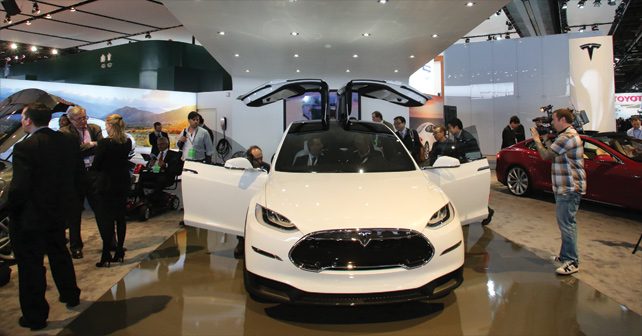
Jens wonders if Tesla has bitten off more than it can chew?
The hype surrounding the Californian start-up Tesla knows few boundaries. Founded in 2003 by five investors, including CEO Elon Musk, the company launched its Lotus-based Roadster in 2008 – followed by the Model S sedan, which has become a surprise success in several global markets, most notably in California. But it’s also sold exceptionally well in some European markets – particularly those where electrics enjoy a huge political and financial tail wind.
Elon Musk has eloquently detailed his plan is to make electric cars available to the masses – by starting out with upmarket vehicles, the profit from which would fund the development of cheaper cars with appeal to an ever-widening circle of customers. One of the problems with this plan is that Tesla has never made any profit with its vehicles. Another problem? The company’s third model, the Model X, is even more expensive than the Model S.
Tesla’s latest model was unveiled in late September at the company’s headquarters in Fremont, California. That’s the production site that Toyota handed over to Tesla under especially generous financial terms. In typical fashion, the company CEO Elon Musk was greeted by the invited (and initiated) crowd with jubilant cheers – indeed, many Tesla owners are a fiercely loyal bunch to the point of resembling a spiritual order.
I like to evaluate cars from a technical perspective, and the Model X is an impressive one from almost every perspective. It’s very powerful, and it sports some electronic gadgets that set it apart from anything else on the market. For now, this all-wheel drive crossover comes in two configurations – with 525 horsepower, or an almost incredible 773 horsepower. Even though the motors have to move two-and-a-half tonnes of metal and plastic, they provide great performance. The least powerful Model X sprints from 0 to 100km/h in less than 5 seconds – the fastest version manages it in just over 3 seconds. That’s in the realm of supercars. Top speed is governed at 250km/h. Less powerful versions will come later.
The problem with these figures – and this is safe to assume even before we’ve driven the car – is that they cannot be attained consistently. From our experience with the Model S, performance drops sharply after a few acceleration runs – because the battery and propulsion systems start overheating. And the range of the vehicle – the Model X gets around 350 kilometres under fairly ideal conditions – drops mercilessly with each squeeze of the right pedal.
The list of gadgets is this vehicle’s appeal, but perhaps also its downfall. It includes the vaunted motorised rear doors that open upwards. Called ‘falcon wings’ by Tesla, they’ve proven very complex to engineer, with limited advantages. There is also a massive windshield that Tesla calls “the biggest in the industry.” But I remember when Opel tried an extended windshield on the Astra GTC – they were prone to damage and were eventually dropped from the options list. The interior air filtering system includes – and this is no joke – a “bioweapon defence setting.”
When Musk held up the A/C system’s massive air filter and compared it to a competitor’s small filter, the assembled crowd reportedly jeered at the competition’s incompetence. But how much sense does such a massively over-engineered part make in an electric vehicle, where every gram of weight counts. Not to mention the fact that it has absolutely no function – unless you believe bio-warfare is a likely scenario for Long Beach and Santa Barbara? Meanwhile, quite fittingly, a costly software setting that unlocks a bit of extra acceleration is called “Ludicrous mode.”
Oddly enough, the Model X comes in a package that looks positively dated. Its soft lines and bulbous greenhouse remind us of the long-forgotten era of ‘organic design.’ Concept cars like the 1990 Oldsmobile Expression managed to pull it off with more sophistication. Today, the closest thing to a Model X is BMW’s 5-series Gran Turismo.
Somewhat ominously and, perhaps for the first time, media reaction is not unanimously positive. Lawrence Ulrich of The Drive notes that “the Model X may be a 2.5-tonne warning sign that the company is either unwilling or unable to pull it off.” And further, “Tesla appears no closer to its promise of bringing affordable electric cars to the masses.” A writer for the magazine Motor Trend created a stir on Facebook by calling the Model X “ugly.”
Meanwhile, the competition is gearing up to take on the challenge. Unveiled at the Frankfurt auto show, Audi’s fully electric e-tron Quattro concept is aimed squarely at the Tesla Model X – with more sophistication and more convenience, such as inductive charging. And Porsche showed the Mission E, a sports sedan targeting the Model S. Even Mercedes-Benz is working on a fully electric SUV as well, as Cadillac and BMW are focusing on plug-in hybrids. All of this suggests that Tesla’s reign over the segment of premium electric cars – regardless of the eventual size of that market – is about to come to an end. Last year, a German supplier executive prophetically whispered this to me: “Tesla has created an avalanche that is going to bury them.”























Write your Comment